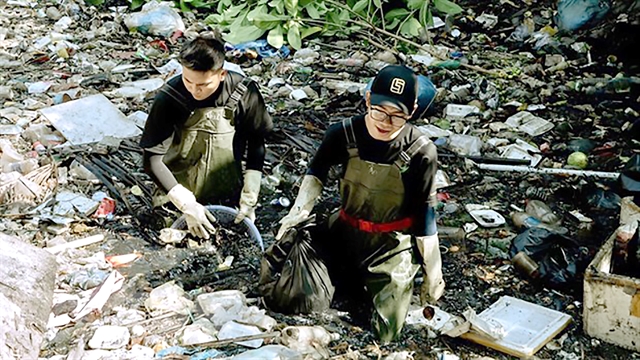 Environment
Environment

 |
| HCM City’s canals are again polluted by garbage and untreated wastewater a few years after many were cleaned up. – VNA/VNS Photo |
HCM CITY – HCM City’s canals, thoroughly cleaned a few years ago, are again severely polluted because of dumping of waste and untreated wastewater, vietnamplus.vn reported.
The Tân Hóa-Lò Gốm Canal, which passes through Districts 6, 11 and Tân Phú, is again polluted after a VNĐ5 trillion clean-up in 2015.
The project built 8,000m of sewers to collect wastewater and 12km of road along its banks, dredged 300,000cu.m of mud, and put up signs to raise awareness among local people about environmental protection.
But after eight years its water has again turned dark, often had unusual white bubbles since the beginning of this year and become stinky with plastic and household wastes floating on the surface, Lê Hoàng Chương, who lives along it in District 6, said.
“Since it is the rainy season, the problem has been exacerbated with a large amount of trash being swept into the canal.”
The Nhiêu Lộc-Thị Nghè Canal that flows through the city centre has also been facing similar issues after being cleaned up 10 years ago at a cost of VNĐ8.6 trillion.
It has waste swept in by the rains, and its waters are black and smell unpleasantly in Tân Bình District, and there are frequent occurrences of mass fish deaths.
Waste is collected twice a day from the Tân Hóa-Lò Gốm canal and once from the Nhiêu Lộc-Thị Nghè Canal, but an overwhelming 16 tonnes of domestic waste everyday is to blame, the HCM City Urban Environment Company said.
Most of it is plastic waste, carcasses of pets and discarded furniture, Huỳnh Minh Sơn, the head of a garbage collection centre along the Tân Hóa-Lò Gốm Canal, said.
The city has been making plans for building and renovating its drainage system so that wastewater is treated before being released into canals, Trần Minh Quân, head of the city's Environmental Protection Agency, said.
The city has three central treatment plants and four others in residential areas, but only processes 12.6 per cent of the total wastewater, he admitted.
“By 2025, it aims to ensure 80 per cent of areas have proper drainage, 80 per cent of wastewater is collected, and increase wastewater treatment efficiency to over 40 per cent by constructing more treatment facilities.”
In the Tân Hóa-Lò Gốm Canal, authorities have been soliciting investments to build a wastewater collection system and a treatment plant for three basins, Tây Sài Gòn, Tân Hóa-Lò Gốm and Bình Tân.
The city's Department of Natural Resources and Environment said it has been tightening oversight of water treatment at factories and industrial facilities.
Places that generate large volumes of wastewater, such as industrial clusters, are required to have a water quality monitoring system by the end of next year.
It has been hosting events on environmental protection like the “Sống Xanh” (Go Green) Festival and the “Make the World Greener” Campaign in many of the city’s districts to spread awareness and encourage locals to prevent water pollution. – VNS




